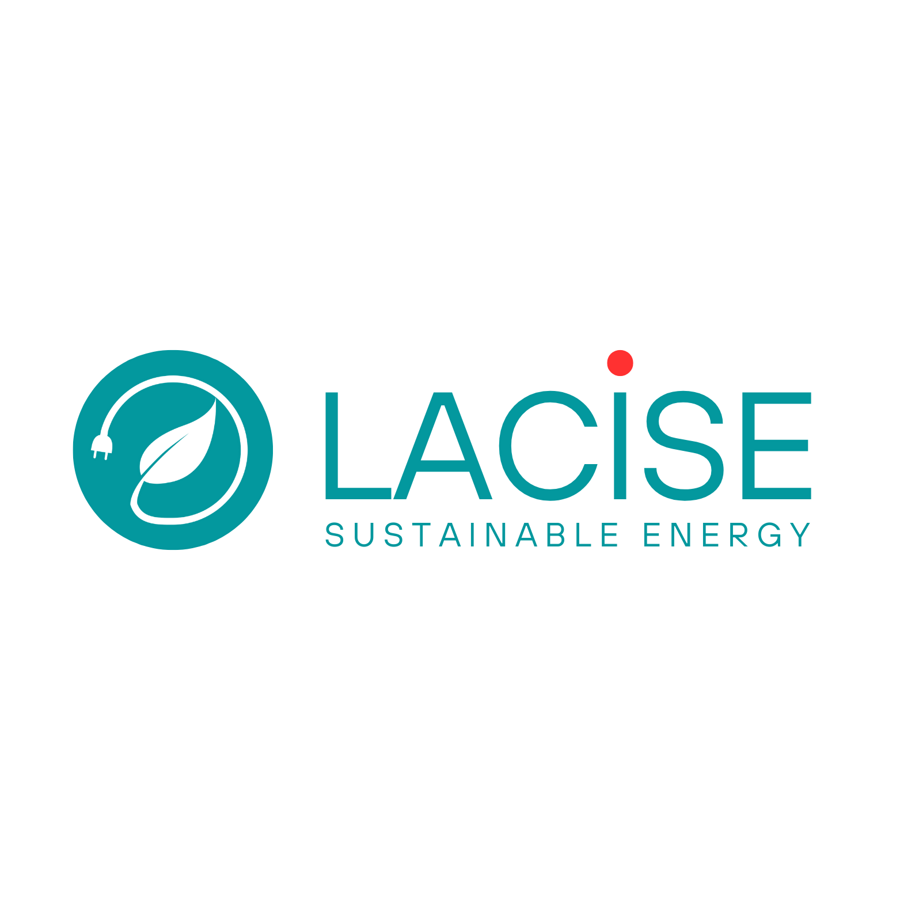Shaping the Future of Energy: ISSP UL’s Role in the LACISE Project
 ISSP UL's team at the Energy Materials Laboratory: Ināra Ņesterova, Maija Bebre, Niks Smelters, Inese Jansone, Anzelms Zukuls, Gints Kučinskis. Photo: Laura Ločmele.
ISSP UL's team at the Energy Materials Laboratory: Ināra Ņesterova, Maija Bebre, Niks Smelters, Inese Jansone, Anzelms Zukuls, Gints Kučinskis. Photo: Laura Ločmele.
The Institute of Solid State Physics, University of Latvia (ISSP UL) is a key partner in the LACISE project—one of two projects under the Swiss–Latvian cooperation programme “Partnership in Applied Research.” From the outset, ISSP UL has played a dual role: coordinating two major research directions—batteries and hydrogen—and managing project administration to ensure smooth implementation and effective collaboration with partners.
Within the project, ISSP UL leads Work Package 1 (WP1), which covers project management, communication, dissemination, and industry engagement. Our responsibilities include coordinating activities, organizing strategic meetings, and overseeing the creation of the Digital Swiss–Latvian Competence Centre for Smart Energy. Through conferences, seminars, and public outreach, we aim to inspire the next generation of scientists and encourage young people—especially girls—to pursue careers in STEM.
WP1 is implemented by the LACISE project coordinator, Dr. phys. Gints Kučinskis, Head of the Energy Materials Laboratory at ISSP UL. Administrative coordination is managed by Maija Bebre, with support from Ieva Piņķe, while communication activities are planned and executed by Inese Jansone.
ISSP UL also manages two additional work packages: WP4 and WP5.
- WP4 focuses on next-generation battery technologies. Our team is developing cobalt-free cathode materials and silicon-enhanced graphite anodes, assembling full battery cells, and applying advanced methods to analyze the aging mechanisms of these cells. The goal is to create safer, longer-lasting batteries suitable for grid-scale energy storage. Key contributors include Gints Kučinskis, Niks Smelters, Ināra Ņesterova, Alīna Paula Ķirse, Ansis Mežulis, and others.
- WP5 explores sustainable hydrogen production, specifically using waste aluminum from end-of-life window frames, beverage packaging, and other aluminum-containing materials. Our aim is to develop efficient, environmentally friendly hydrogen production technologies. This work involves researchers from the Energy Materials Laboratory, including Līga Grīnberga, Ainārs Knoks, Anzelms Zukuls, Ņikita Griščenko, and several master’s and bachelor’s students.
The ISSP UL fosters collaboration with Latvian partners—the Institute of Electronics and Computer Science and Riga Technical University—as well as Swiss partners: the Paul Scherrer Institute, Zurich University of Applied Sciences, and the Swiss Center for Electronics and Microtechnology. Together with our Swiss colleagues, we have initiated training programs for new researchers.
“LACISE is a very important project for our institute. It enables us to advance research in battery and hydrogen energy while supporting the professional growth of young scientists. The project creates opportunities to strengthen ties with local and international industry and lays the foundation for long-term partnerships with leading Swiss research institutes,” says Gints Kučinskis, Head of the Energy Materials Laboratory and project coordinator.
For ISSP UL, LACISE is more than a project—it is an opportunity to shape the future of energy through research, collaboration, education, and the engagement of the next generation.
LACISE Project Representatives Participate in the SGEM Vienna Green Conference
 Ņikita Griščenko and Anzelms Zukuls at the SGEM Vienna Green conference
Ņikita Griščenko and Anzelms Zukuls at the SGEM Vienna Green conference
From December 3 to 6, the international conference SGEM Vienna Green took place in Vienna, Austria, bringing together experts in sustainability, environment, and energy. The LACISE project was represented by researchers Anzelms Zukuls and Ņikita Griščenko from the Institute of Solid State Physics, University of Latvia (ISSP UL), who presented results achieved within WP5. The project team participated with a poster presentation titled “Aluminum waste to hydrogen: an on-site solution”. The study was authored by ISSP UL Energy Materials Laboratory researchers Ņikita Griščenko, Anzelms Zukuls, and Līga Grīnberga.
During the conference, participants gained extensive insights into current research on sustainable energy systems, climate-resilient urban planning, biodiversity conservation, as well as advanced technologies for clean energy production and waste management. Special attention was given to hydrogen technologies, their development trends, and potential applications in future energy systems.
Participation in this conference fostered knowledge exchange and collaboration opportunities with the international scientific community, strengthening the LACISE project’s contribution to sustainable energy development.
SGEM Vienna Green – Green Sciences for Green Life is an international scientific conference held annually, gathering around 550 participants from Europe and beyond — researchers, academics, policymakers, environmental consultants, and students. The main topics include biodiversity, reduction of CO₂ emissions, renewable energy, sustainable urban planning, clean technologies, biotechnology, and environmental policy. The conference features sessions, panel discussions, and poster presentations, promoting academic dialogue and cooperation.
Why choose STEM? Andris Šutka shares his experience with students
 Photo: Smiltene Secondary School
Photo: Smiltene Secondary School
At the beginning of December, Andris Šutka, tenured professor and Director of the Institute of Physics and Materials Science at Riga Technical University (RTU), visited Smiltene Secondary School. Within the LACISE project, he leads the RTU research team working on sustainable hydrogen production solutions. The event brought together students from grades 10–12 who have chosen to study chemistry in depth.
Andris Šutka is a graduate of Smiltene Secondary School (2004), and this visit was a special reunion with his former school and chemistry teacher, Jānis Celmiņš. During the meeting, the professor shared his experience in science, spoke about research directions, and explained how scientific achievements are made – step by step. He emphasized that STEM fields are not only full of challenges but also offer broad opportunities for growth and diverse career paths.
Addressing the students, Prof. Šutka inspired them by saying that science is not just theory; it is also creativity, innovation, and a real chance to shape the future. He encouraged young people not to be afraid and to choose their own path in the diverse world of STEM. The meeting was a great opportunity for students to see that science begins right there – at school – and can lead to world-class discoveries.
Hydrogen from Everyday Waste – A School Student Research on the Energy of the Future Inspired by LACISE
 Gustavs Lukašs and Ņikita Griščenko at the Energy Materials Laboratory of the Institute of Solid State Physics, University of Latvia. Photo - Anzelms Zukuls.
Gustavs Lukašs and Ņikita Griščenko at the Energy Materials Laboratory of the Institute of Solid State Physics, University of Latvia. Photo - Anzelms Zukuls.
Imagine if everyday aluminum waste could hold the key to cleaner energy. That’s the question explored by Gustavs Lukašs, an 11th-grade student at Riga State Gymnasium No. 1, who has chosen the chemistry and biology track at school. Gustavs is among the young innovators inspired by the LACISE project, which offers a unique chance to tackle real-world STEM challenges and collaborate with scientists.
From Idea to Laboratory Experiments
Gustavs discovered the LACISE project on social media while searching for opportunities to develop his scientific research paper (SRP) in a professional lab setting. His chosen topic – “The Potential for Hydrogen Production from Various Household Aluminum-Containing Waste” – bridges chemistry, biology, and sustainable energy. The goal? To determine how efficiently hydrogen can be generated from different aluminum waste materials (foil, beverage cans, shavings, etc.) by comparing reaction rates and hydrogen yield based on material properties.
 Research reactor and waste aluminum. Photo - Anzelms Zukuls.
Research reactor and waste aluminum. Photo - Anzelms Zukuls.
Hands-On Experience – A Step Closer to Science
Laboratory work has been both thrilling and challenging for Gustavs. He’s mastered skills rarely accessible to high school students: operating electron and optical microscopes, using an X-ray diffractometer, and assembling the reactor needed for his experiments.
“All these skills will be invaluable if I choose a career in science,” Gustavs shares. His research takes place at the Energy Materials Laboratory of the Institute of Solid State Physics, University of Latvia, equipped with cutting-edge technology and expert guidance. He credits his mentors – Mg.sc.ing. Ņikita Griščenko and PhD Anzelms Zukuls – for their support, which has made the process smooth and rewarding.
LACISE – Building Bridges Between Schools and Science
This story captures the essence of the LACISE project: connecting young minds with the scientific community, promoting STEM fields, and inspiring the next generation of researchers. Gustavs’ experience shows that working alongside scientists not only deepens knowledge but also provides practical skills that can shape future career choices.
In Gustavs’ Own Words
“If all scientists are as supportive as my mentors, I wholeheartedly recommend other students to seize such opportunities,” he says. The LACISE project proves that science isn’t just theory – it’s exciting, hands-on, and accessible to students.
LACISE sparks curiosity: young minds explore sustainable energy at ISSP UL
 Stende Lower Secondary School students at the ISSP UL. Photo - ISSP UL
Stende Lower Secondary School students at the ISSP UL. Photo - ISSP UL
The Institute of Solid State Physics, University of Latvia (ISSP UL), continues its long-standing tradition of welcoming school excursions, offering young learners a unique opportunity to explore the world of physics and scientific discovery. These visits aim to showcase the practical applications of physics and inspire interest in science-related careers.
In October, students from Stende Lower Secondary School visited ISSP UL to learn about the institute’s wide-ranging research activities, notable scientific achievements, and ongoing projects.
During the visit, students toured several laboratories, including the Energy Materials Laboratory, where researchers are actively involved in the LACISE project. Here, students gained valuable insights into cutting-edge technologies, including lithium and sodium batteries—their materials and research into their longevity—as well as hydrogen production. They also learned about the crucial role of scientific research in promoting climate neutrality and developing sustainable energy solutions.
The excursion provided a hands-on introduction to the practical side of physics and highlighted the diverse career paths available in the field. To further engage students, ISSP UL invited them to participate in upcoming events, such as the Physics Festival. Additionally, students were encouraged to apply for next year’s Solar Cup competition and Job Shadow Day, which offers firsthand experience of a physicist’s daily work.
Hands-On with Hydrogen: LACISE Project Team Joins Swagelok Tubing System Training
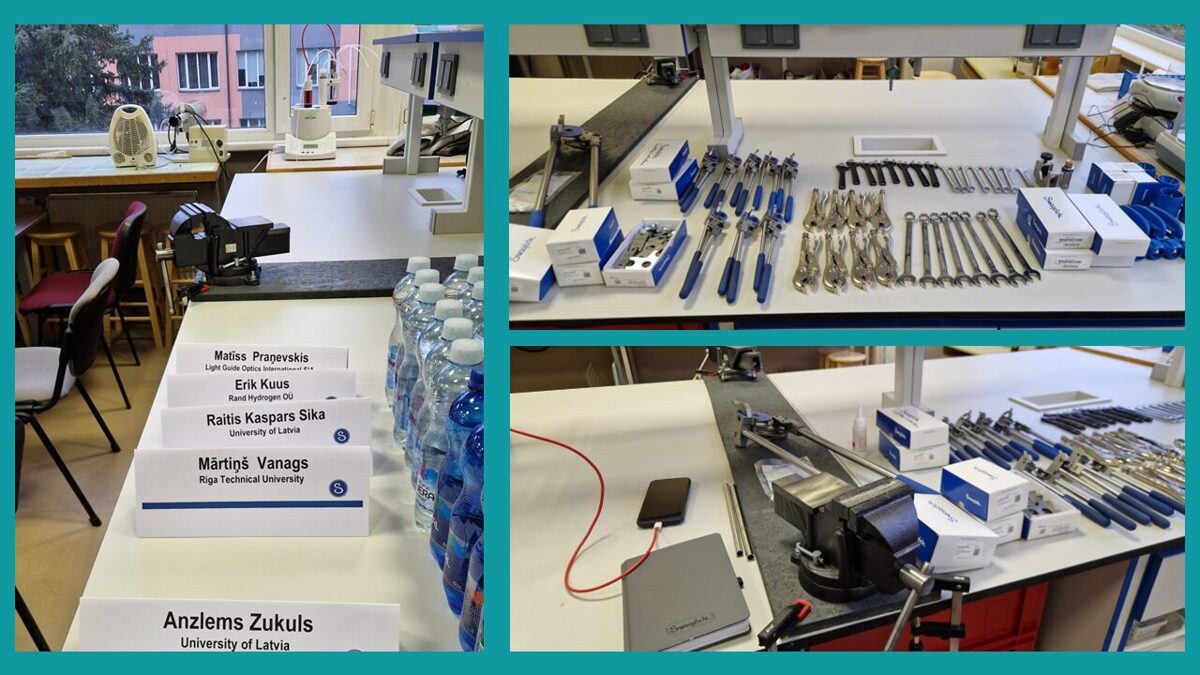 Photos - Matīss Vaivods
Photos - Matīss Vaivods
On October 27–28, representatives from the LACISE project participated in a two-day intensive training focused on designing and installing hydrogen tubing systems. The training took place at Riga Technical University (RTU) and brought together experts and researchers working on hydrogen technologies.
The LACISE team was represented by Anzelms Zukuls and Raitis Sika from the Institute of Solid State Physics, University of Latvia, along with Mārtiņš Vanags from RTU. The training was led by specialists from Swagelok Helsinki – Technical Development Director Sami Juntunen and Sales Representative / Field Engineer Matīss Vaivods – who shared their expertise in hydrogen system safety and engineering.
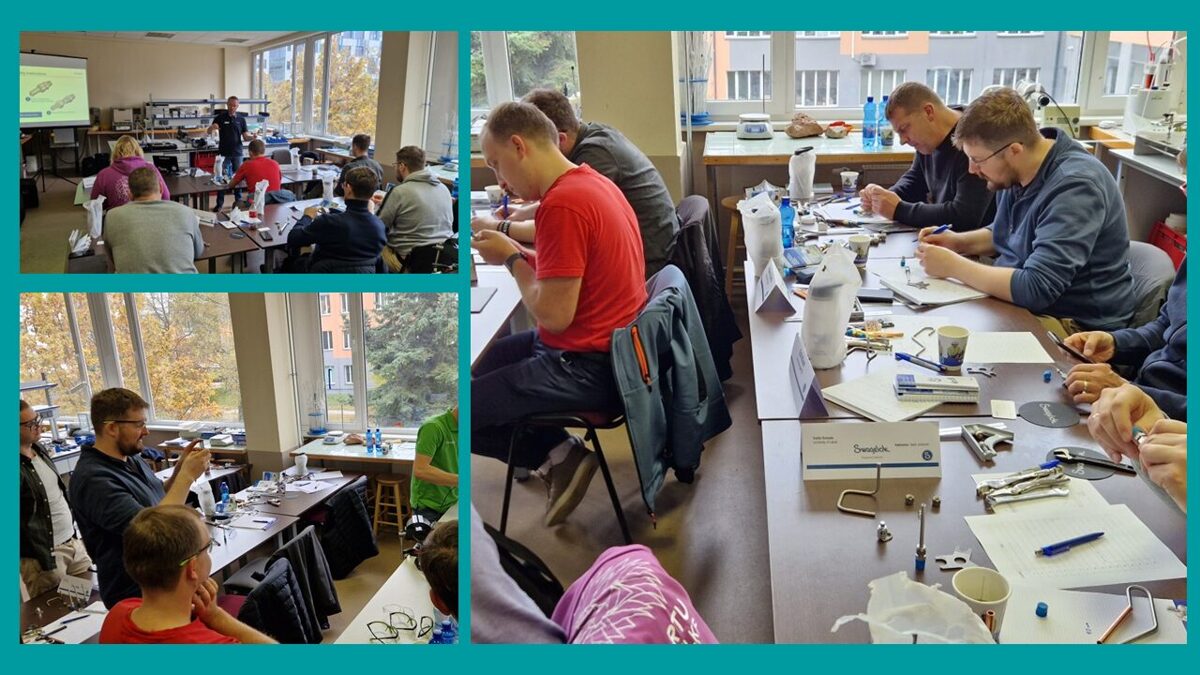 Photos - Matīss Vaivods
Photos - Matīss Vaivods
The aim of the training was to equip participants with both theoretical knowledge and practical skills for the safe and efficient construction of hydrogen gas systems. Topics covered included the correct use of Swagelok connection systems in hydrogen infrastructure, tube bending techniques, material selection, and identification of common installation errors. Participants also had the opportunity to engage in hands-on tube assembly and connection work, gaining valuable experience in building hydrogen-resistant systems.
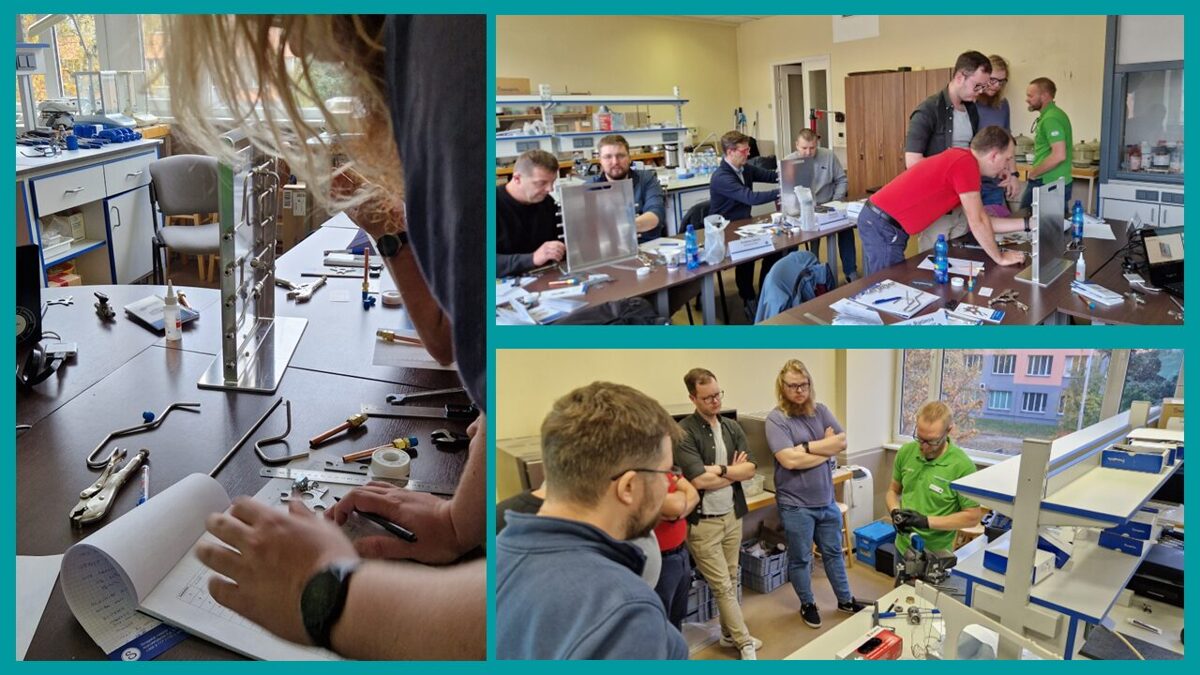 Photos - Matīss Vaivods
Photos - Matīss Vaivods
A highlight of the training was the demonstration of damage detection using hydrogen sensors, offering insights into diagnosing and resolving faults in gas system components.
This practical experience is a significant step forward for the LACISE project, supporting its continued development in the field of hydrogen technologies and reinforcing its commitment to safety and innovation.
LACISE Team Partners with Eco Baltia vide to Access Aluminum Waste for Research
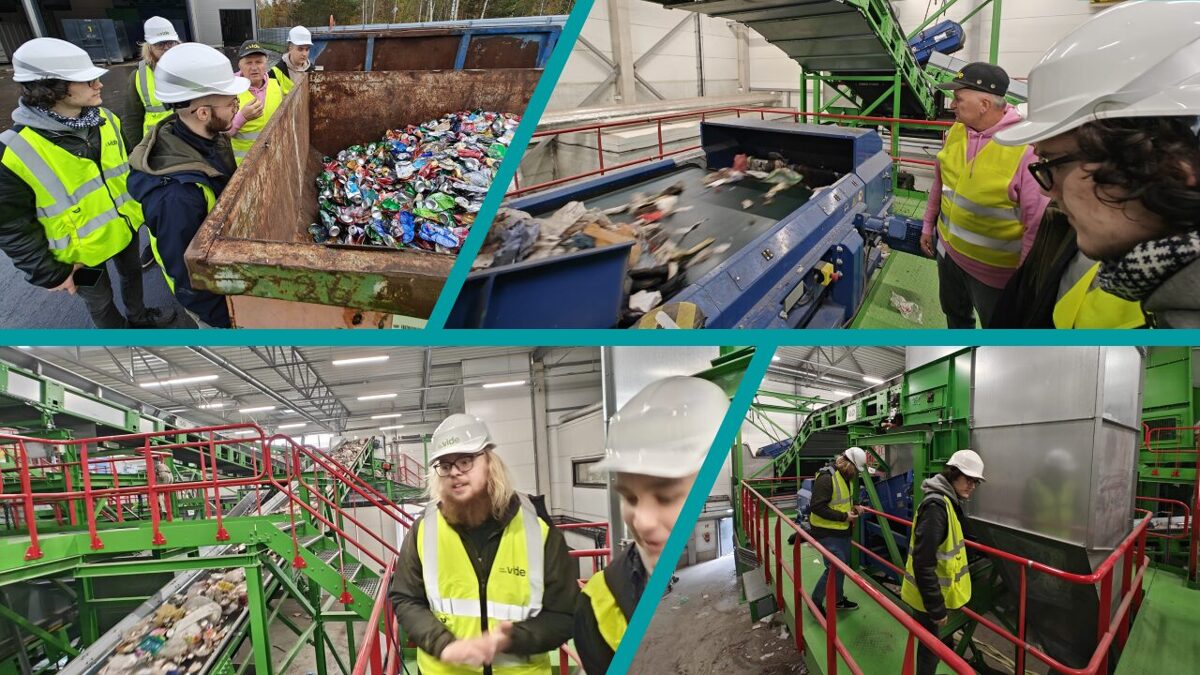 ISSP UL team visits Eco Baltia vide. Photo - Anzelms Zukuls
ISSP UL team visits Eco Baltia vide. Photo - Anzelms Zukuls
On October 14, 2025, LACISE project representatives Anzelms Zukuls, Ņikita Griščenko, Daniels Jurjevs, Raitis Sika, and Rendijs Ronis visited Eco Baltia vide’s Resource Management Center in Riga. They were welcomed by Kristaps Dreimanis, Head of the Sales Department, and Vents Kārkliņš, Production Manager. The visit aimed to learn about sorting processes for household waste containing aluminum, understand its composition, and explore potential recycling pathways. The LACISE team received an in-depth tour of the waste sorting line and discussed the technical aspects of material selection and preparation for research purposes.
A key outcome of the visit was the formalization of a collaboration between the LACISE project and SIA Eco Baltia vide. This partnership will grant the project access to sorted, aluminum-containing household waste, materials that are particularly valuable for experiments and analyses requiring representative aluminum-rich fractions. This milestone marks a significant step toward practical industry collaboration, enabling access to real-world materials and supporting sustainable research endeavors.
 SIA Eco Baltia vide waste aluminum. Photo - Anzelms Zukuls
SIA Eco Baltia vide waste aluminum. Photo - Anzelms Zukuls
Moving forward, the teams will define the scope, material sampling protocols, and data-sharing arrangements to maximize the value of the partnership for LACISE’s research objectives. Bridging research with industry through such collaborations enhances our ability to study aluminum sorting and recycling in real waste streams, driving progress toward more sustainable waste management solutions.
ISSP UL team visits Paul Scherrer Institute in Switzerland
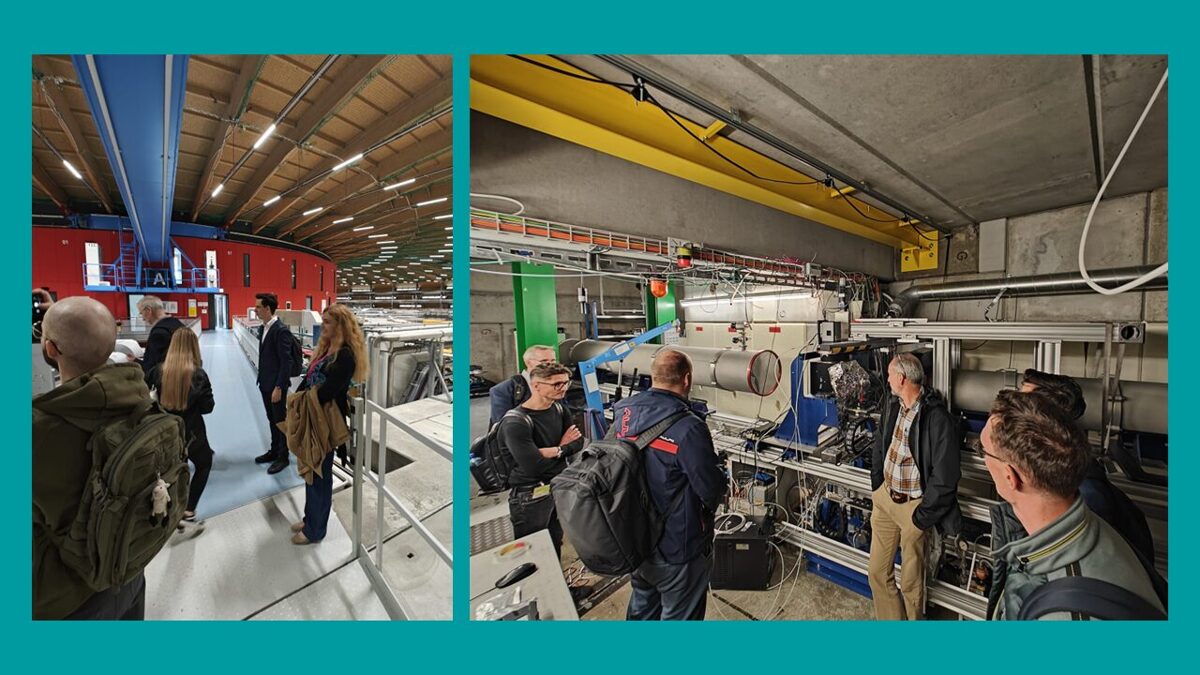
From September 21 to 24, representatives of the LACISE project from the Institute of Solid State Physics, University of Latvia (ISSP UL) – Dr. Gints Kučinskis, Dr. Anzelms Zukuls, and PhD students Ņikita Griščenko and Ināra Ņesterova – visited the Paul Scherrer Institute (PSI) in Switzerland. The purpose of the visit was to strengthen collaboration with project partners, align future research directions, and explore the institute’s infrastructure and research capabilities.
During the visit, discussions were held with LACISE project collaborators regarding the progress of ongoing research, coordination of upcoming experiments, and opportunities to utilize PSI’s equipment and operando measurement cells.
Meetings also took place with Dr. Sigita Trabesinger to discuss battery research, and with Dr. Emiliana Fabbri and Dr. Javier Quilez Bermejo to address specific work package tasks and future collaboration plans. Potential student exchange mechanisms were explored, and a follow-up visit to PSI with a longer stay was planned.

The visit included tours of laboratories and research facilities, as well as participation in the “Operando Day” seminar, where students and researchers presented current studies and discussed methodological and measurement adaptations.
This mission provided a valuable opportunity to reinforce partnerships, expand knowledge on the use of international research infrastructure, and plan the next steps in the LACISE project’s scientific work.
LACISE Project Featured at The Riga Conference 2025
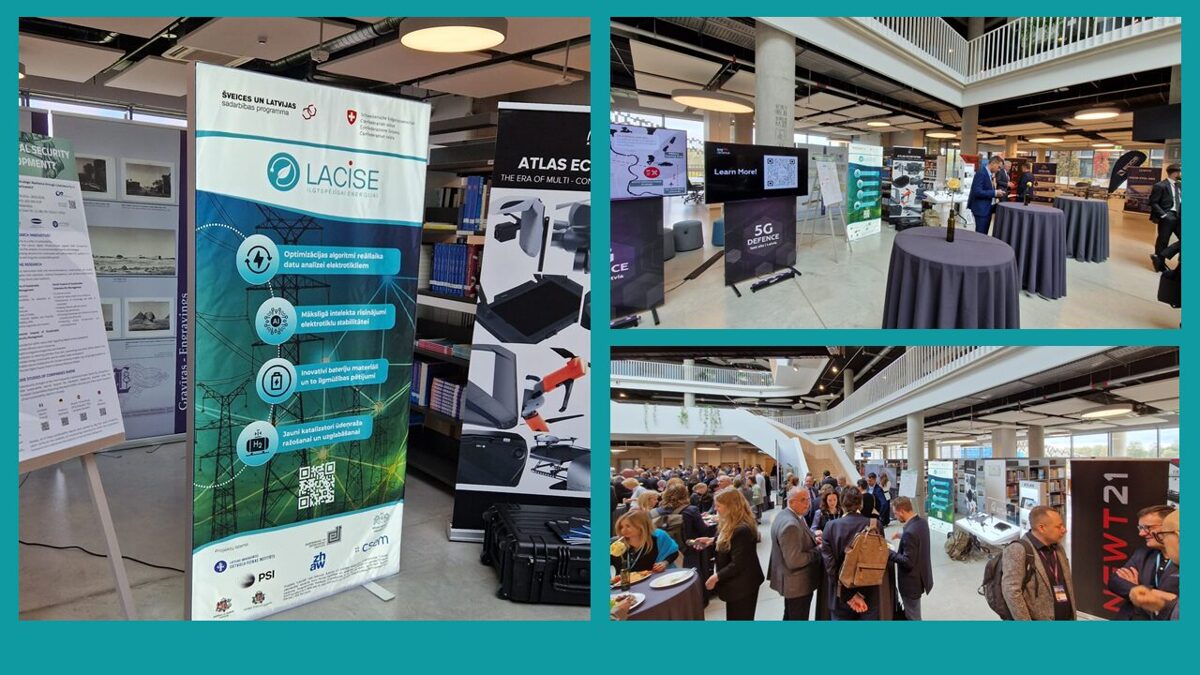 LACISE light box at the Riga Conference 2025. Photo - Gints Kučinskis.
LACISE light box at the Riga Conference 2025. Photo - Gints Kučinskis.
The LACISE project was showcased at The Riga Conference 2025, held from October 9–11 at the House of Science, University of Latvia. As the largest security and foreign policy forum in the Nordic-Baltic region, the conference brought together over 700 participants from approximately 45 countries, including policymakers, defence and security experts, diplomats, academics, journalists, and business leaders.
LACISE was represented in the exhibition area, where a dedicated project light box introduced attendees to this strategically important initiative for Latvia’s energy future. The display highlighted LACISE’s role in strengthening national energy resilience and advancing Latvian expertise in the energy sector. Dr. phys. Gints Kučinskis, the project coordinator, was also present, engaging with participants and emphasizing the project’s relevance in the broader context of European strategic investment and sustainability.
The conference featured high-level speakers such as Latvian Prime Minister Evika Siliņa, President of the European Parliament Roberta Metsola, EU Commissioners Andrius Kubilius and Valdis Dombrovskis, U.S. Permanent Representative to NATO Matthew J. Whitaker, and former NATO Military Committee Chair Admiral Rob Bauer, alongside experts from Europe, Asia, and the Americas.
Discussions focused on key themes including NATO’s future, Ukraine’s long-term security, strategic investment in European defence, Baltic Sea regional security, hybrid warfare, geoeconomics, and business resilience.
The event was organized by the Latvian Transatlantic Organisation (LATO) in cooperation with the Ministry of Foreign Affairs, the Ministry of Defence, the University of Latvia, the European Commission Representation in Latvia, and the Konrad Adenauer Foundation. It was supported by the embassies of Sweden, France, Spain, Germany, the Netherlands, Turkey, Israel, and Canada.
LACISE’s presence at this prestigious event underscores its growing visibility and importance in shaping Latvia’s energy landscape and contributing to regional resilience.
More about the event on the Riga Conference 2025 website.
Progress of the Swiss-Latvian Cooperation Programme “Partnership in Applied Research” is assessed at first Steering Committee meeting

On October 3, 2025, the first meeting of the Steering Committee of the Swiss-Latvian cooperation programme “Partnership in Applied Research” took place at the Ministry of Education and Science. During the meeting, the progress of the program was evaluated and decisions on further steps were made. The meeting was attended by representatives from the Ministry of Education and Science, the Embassy of the Swiss Confederation, the Ministry of Finance, the Latvian Council of Science, Riga Technical University, the Institute of Solid State Physics, University of Latvia, and EMPA (Swiss partner).
The main objective of the programme is to strengthen Latvia’s scientific and innovation capacity by strengthening cooperation with Swiss research institutions and promoting sustainable growth. Two significant projects are being implemented under the programme: LACHMAT is developing new solutions for road surfaces, concrete technologies, and 3D-printed concrete using local minerals. LACISE, on the other hand, focuses on smart energy grids, new battery materials and hydrogen technologies from aluminium waste.
Both projects have already achieved their first results, involving doctoral, master’s and bachelor’s students. Cooperation with industry has been initiated to ensure the practical application of research results, and the first innovative solutions for sustainable infrastructure and energy are being
The Steering Committee also \ reviewed the programme’s communication plan. It aims to raise public awareness of Switzerland’s contribution, strengthen young people’s interest in STEM fields, and ensure the visibility of results in Latvia and beyond.
Future plans include developing new solutions in collaboration with industry, establishing a digital competence centre for energy storage and smart grids, and strengthening the involvement of young people and schoolchildren in science.
The Swiss-Latvian cooperation programme “Partnership in Applied Research” confirms that international cooperation makes a significant contribution to both science and society.
The total budget of the programme until 2029 is EUR 12,352,941, of which Switzerland’s co-financing is 85% or EUR 10,500,000, while the Latvian state budget co-financing is 15% or €1,852,941. The programme is implemented by the Ministry of Education and Science in cooperation with the Latvian Council of Science.
When Science Becomes an Adventure – LACISE Debuts at European Researchers’ Night
 LACISE at the Researchers' Night - Hydrogen bubbles, hydrogen vehicle model, demonstration - How hydrogen is produced. Photo: Valdis Jansons
LACISE at the Researchers' Night - Hydrogen bubbles, hydrogen vehicle model, demonstration - How hydrogen is produced. Photo: Valdis Jansons
On the evening of September 26, the 20th European Researchers’ Night took place under the inspiring slogan “Discover the Researcher Gene Within You.” This year marked the debut of the LACISE project at the event, offering a wide range of engaging activities in the 3rd-floor lobby of the Institute of Solid State Physics, University of Latvia (ISSP UL).
The ISSP UL’s Energy Materials Laboratory, which is directly involved in the project's scientific work, ensured that Researchers’ Night became a memorable evening for both young and old. Highlights included exploding hydrogen bubbles, models of hydrogen- and solar-powered cars, a live demonstration of hydrogen production, and a challenging quiz game. Guests had the opportunity to interact with researchers, watch the car models in action, and even experience the thrill of popping hydrogen bubbles.
 Solar-powered and hydrogen-powered vehicle models, participants of the LACISE quiz. Photo: LACISE project
Solar-powered and hydrogen-powered vehicle models, participants of the LACISE quiz. Photo: LACISE project
Visitors also tested their knowledge in a quiz game created by LACISE scientists. Hosted on the Kahoot! platform, the game featured four themed quizzes: batteries, hydrogen, energy, and the LACISE project. Participants could choose a topic and tackle 10 tricky questions, with LACISE souvenirs awarded to winners. Throughout the evening, 35 quiz sessions were held, attracting 146 participants.
 LACISE quiz participants. Photo: LACISE project.
LACISE quiz participants. Photo: LACISE project.
This year, ISSP UL welcomed a record-breaking crowd of over one thousand science enthusiasts. Many were upper-grade students, but the event also drew strong interest from families with preschool and primary school-aged children, all eager to spend their Friday evening discovering something new.
The LACISE project extends its heartfelt thanks to all visitors for their enthusiasm and curiosity.
European Researchers’ Night was first held in 2005. The event was designed to foster public understanding of science and research, demonstrating that science is exciting, accessible, and relevant to everyday life. Each year, Researchers’ Night invites the public to visit research and educational institutions to see how science is made, meet researchers, ask questions, and participate in various activities. At the same time, the event aims to inspire young people to pursue careers in science, especially by engaging students and encouraging interest in STEM fields.
Bridging Baltic and Swiss energy research: IECS’ visit to ZHAW
 Photo: IECS team visits ZHAW colleagues.
Photo: IECS team visits ZHAW colleagues.
As part of the LACISE project, the IECS team conducted an exchange visit to its Swiss partners in Winterthur, hosted by the Zurich University of Applied Sciences (ZHAW). From September 3 to 6, this experience exchange aimed to deepen IECS collaboration with ZHAW researchers, to become acquainted with the university’s energy research strengths, and participate in a hands-on seminar on the PowerFactory modeling tool.
The visit began with a warm welcome at ZHAW’s Institute of Energy Systems and Fluid Engineering, where the IECS team—Anna Mutule, Antons Hančevskis, Aleksejs Onackis, Roberts Lazdiņš, and Laura Birzenberga—engaged in a comprehensive overview of ZHAW’s ongoing research. Key areas of focus included in-depth frequency measurement data analysis, energy system modeling with experimental equipment, strategies for optimizing inverter efficiency, and the practical applications of the OPAL-RT real-time simulator.
The central objective of the trip was advancing the dynamic modeling of the Baltic energy system, a core activity within Work Package 2 (WP2) of the LACISE project. Participants discussed the challenges facing Baltic and broader European energy systems, notably the rapid growth of inverter-based generation across all voltage levels. This trend is reshaping the generation mix, impacting frequency stability, and underscoring the need for dynamic security assessment tools to help system operators navigate a changing landscape of generation and consumption.
During the visit, the IECS team took part in a hands-on PowerFactory workshop led by Dr. Miguel Ramirez Gonzalez and Dr. Artjoms Obusevs.

Joint discussions with ZHAW colleagues culminated in a concrete plan for collaboration, including:
- Data acquisition and export workflows within the PowerFactory environment.
- Application of modeling approaches to the Baltic energy system, with an eye toward scaling and transferability.
- Utilization of the developed models to support ongoing scientific cooperation and strengthen international projects.
The visit underscored the value of cross-border collaboration in tackling contemporary energy challenges.
IECS team extends their thanks to all colleagues at ZHAW for their hospitality and insights, and looks forward to forthcoming joint activities that will drive innovation in energy systems modeling and resilience.
LACISE IECS delegation visits CSEM to strengthen innovation ties
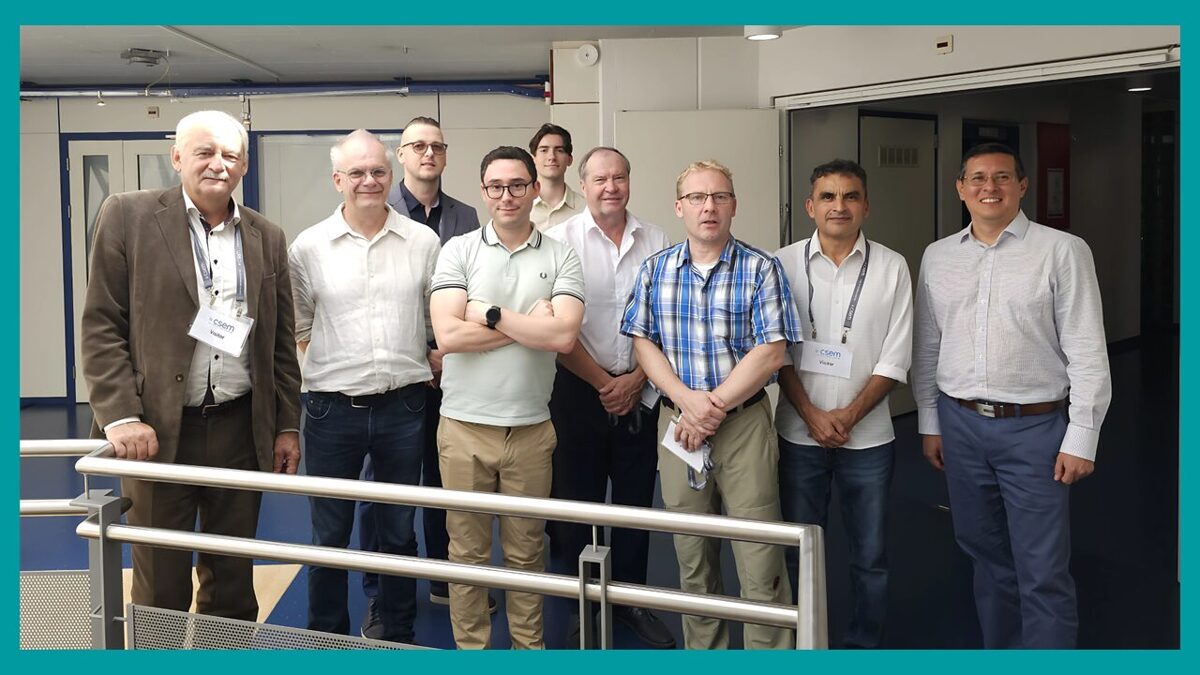 LACISE experience exchange visit at CSEM
LACISE experience exchange visit at CSEM
From August 27–28, the picturesque city of Neuchâtel hosted two days of collaboration, innovation, and forward-looking dialogue as Swiss partners from the Centre Suisse d’Électronique et de Microtechnique (CSEM) welcomed their Latvian counterparts from the Latvian Institute of Electronics and Computer Science (IECS). The aim of the visit was to review the results achieved so far and define the next steps in the research directions of IECS and CSEM in the field of solar radiation forecasting, thereby contributing to the development of more accurate forecasts and models.
Hosted at CSEM’s headquarters, the meeting brought together experts, researchers, and policymakers to explore new opportunities in technology development, renewable energy, and applied research. Participants included representatives from IECS, ZHAW, SECO, and CSEM, each contributing unique perspectives and expertise.
The event opened with a warm welcome from CSEM, followed by progress presentations from IECS researchers Kaspars Sudars, Ivars Namatēvs, and Normunds Andžāns. The IECS researcher presented a new solar radiation measurement station equipped with a sky camera, radiation sensor, and anemometer for synchronized data collection to improve short-term forecasting of photovoltaic output. They also demonstrated their U-Net algorithm for predicting cloud movements and solar irradiance, highlighting the importance of AI-based methods for renewable integration.
Further discussions explored the experiences of CSEM and IECS as research institutions collaborating with industry, as well as topics such as intellectual property management and technology transfer opportunities in Switzerland and Latvia, including how these issues could be addressed within the context of the LACISE project. Participants in this conversation included: Modris Greitāns (IECS Director), Bahaa Roustom (Head of Business Development at CSEM), Philippe Dallemagne (CSEM), Petr Korba (ZHAW), and Nicolas Guigas of the Swiss State Secretariat for Economic Affairs (SECO).
A highlight of the morning was the lab tour, where participants explored CSEM’s clean room facilities and cutting-edge 3D printing capabilities. The afternoon shifted to technical deep-dives on grid data modeling, irradiance sensors, and in-situ deployment, culminating in a visit to CSEM’s battery hub.
The second day focused on the future of the LACISE project, with sessions dedicated to next steps, timelines, and a publication plan. Open discussions encouraged cross-border collaboration, ensuring that the momentum generated during the visit will translate into tangible outcomes.
The gathering underscored the shared commitment of Latvian and Swiss institutions to push the boundaries of applied science and technology. By combining expertise in electronics, microtechnology, and renewable energy, the partnership aims to deliver impactful solutions for both nations and beyond.Article about the LACISE project in the Latvian Academy of Sciences' “Science Bulletin”

The Latvian Academy of Sciences’ “Science Bulletin” (Zinātnes Vēstnesis) (No. 7 (656), July 28, 2025), published an article about the LACISE project implemented within the Swiss–Latvian cooperation program “Applied Research.” The project focuses on researching and developing solutions for both short-term implementation and long-term advancement in key energy sectors, contributing to the stability of the energy supply system, the creation of next-generation batteries, and the enhancement of hydrogen production technologies.
The project aims to address the challenges of modern energy while educating the next generation of scientists. The article notes the project’s commitment to increasing interest in STEM among young people, especially girls. It describes how students participate in research while school students engage in activities that foster scientific curiosity.
The article mentions that the Stakeholder Advisory Board has been founded, in which Latvian and Swiss companies and public organizations participate, to ensure the practical application of research results. The Swiss–Latvian Competence Center has also been established within the framework of LACISE, with activities aimed at promoting cooperation, innovation, and knowledge exchange between scientists from both countries.
The significance of the project is underscored by total funding of €7.144 million, which enables technology development by attracting leading scientists, enhancing youth involvement, and driving practical innovations.
Following an introduction to the LACISE project, readers of the “Science Bulletin” article learn about the Swiss–Latvian cooperation program, particularly its Applied Research sub-programme—its origins and evolution—and the potential of such scientific collaboration between the two countries to address global challenges.
The “Science Bulletin” (Zinātnes Vēstnesis) is a joint publication of the Latvian Council of Science, the Latvian Academy of Sciences, and the Association of Latvian Scientists. It covers current events and major advances in Latvia’s science. Published since 1989, it now appears monthly online in Latvian.
Full article in Latvian (pages 6 and 7)Exploring the ISSP UL laboratories: strengthening collaboration and experience among LACISE partners
 LACISE lab tour at the ISSP UL. Photo - Valdis Jansons.
LACISE lab tour at the ISSP UL. Photo - Valdis Jansons.
Following the official project kickoff on May 6, the LACISE consortium partners—including representatives from the Institute of Electronics and Computer Science, Riga Technical University, Paul Scherrer Institute, Zurich University of Applied Sciences, and the Swiss Center for Electronics and Microtechnology—visited the laboratories of the Institute of Solid State Physics, University of Latvia (ISSP UL).
The event began with a brief overview of the institute’s activities, highlighted through key figures and significant milestones, presented by the LACISE coordinator during the official opening. However, the main focus of the visit was to provide participants with a firsthand experience of the state-of-the-art facilities and equipment available at ISSP UL, as well as the talented researchers—both young and seasoned—who operate within these laboratories.
The tour commenced at the Thin Film Laboratory, where attendees learned about ongoing research projects and current initiatives. Next, participants visited the Energy Materials Laboratory, the core research hub for activities related to the LACISE project. The laboratory’s lead researcher, Ainārs Knoks, introduced the team’s hydrogen research, sharing insights into the innovative hydrogen production technologies under development. Guests were also given the opportunity to observe the specialized equipment used by the scientists on a daily basis.
 LACISE partners at the ISSP UL labs. Photo - Valdis Jansons.
LACISE partners at the ISSP UL labs. Photo - Valdis Jansons.
Subsequently, the visitors explored other sections of the Energy Materials Laboratory, which primarily focuses on research into batteries and supercapacitors. Gints Kučinskis, head of the laboratory and coordinator of the LACISE project, discussed the laboratory’s research directions and ongoing projects. The session concluded with an engaging Q&A session, allowing guests to interact directly with the research team.
The tour’s final stop was the largest of the ISSP UL labs—the Spectroscopy Laboratory. Its head, Anatolijs Šarakovskis, provided a detailed overview of the laboratory’s advanced instrumentation and the types of research enabled by each piece of equipment. He outlined the laboratory’s main research areas and responded to questions from the participants.
 Informal discussion after lab tour. Photo - Valdis Jansons.
Informal discussion after lab tour. Photo - Valdis Jansons.
Following the laboratory visits, attendees gathered for a final discussion session. This informal segment allowed partners to reflect on what they had seen and learned, thereby fostering a better mutual understanding. It also served as an opportunity to strengthen personal connections, which are vital for effective collaboration throughout the project. Building trust and camaraderie among partners is essential for smooth communication and the successful implementation of the project.
Project kickoff event features first LACISE Stakeholder Advisory Board meeting

The LACISE project officially commenced with an inspiring kickoff event at the Institute of Solid State Physics, University of Latvia, on May 6. A key feature was the lively panel discussion, which involved members of the Stakeholder Advisory Board (SAB) who shared their insights, expectations, and strategic perspectives on the project’s path forward.
Stakeholder contributions and key messages
Līna Sarma, Riga Tech Girls: Highlighted the importance of talent development, emphasizing that passion drives progress and attracts skilled individuals. She emphasized the importance of effective communication strategies to effectively convey the project’s message and attract the right partners and students.
Pēteris Lesničenoks, Latvenergo: Focused on aligning research with real-world applications. He emphasized the importance of supporting educational programs and the need for clear, practical outcomes that benefit the energy grid.
Aleksandrs Parfinovičs, NACO: Advocated for early involvement of industry experts in project planning to provide scalable advice. He pointed out the lack of standardized methods for evaluating hydrogen technologies, calling for the development of such standards to facilitate broader industry adoption.
Mārtiņš Grels, RIX: Stressed the importance of attracting and nurturing young talent, noting that some industry professionals may hesitate or lack confidence. He encouraged proactive engagement and more frequent updates on hydrogen-related progress, including annual reviews. He also called for feedback on the usability of new technologies and their validation in real-world settings.
Kaspars Liepiņš, Hydrogen Alliance: Focused on the potential of batteries and hydrogen technologies, advocating for meaningful and innovative solutions while minimizing bureaucracy. He expressed interest in EU venture capital and startup opportunities, emphasizing the need to select projects with real market potential.
Minglon He, ABB (remote): Emphasized the importance of predictive models and algorithms, especially for frequency regulation as renewable energy sources increase. He highlighted the role of batteries, hydropower, and gas in maintaining grid stability. He also stressed that industry R&D is largely internal, but collaborative knowledge sharing is essential for innovation. He encouraged engaging students in industry-relevant topics and called for regular technical exchanges and updates to ensure alignment and tangible outcomes, such as grid integration and hydrogen applications.
Kristaps Dambis, Drive eO: Advocated for a global perspective, noting that world-class research must be locally relevant. He emphasized the importance of direct communication and collaboration with scientists, as well as the involvement of young talent in the broader energy transition.
Common themes and future outlook
The panel underscored several recurring themes critical to the project’s success:
- The necessity of talent development and inspiring the next generation of innovators.
- The importance of collaboration across sectors and open communication channels.
- Bridging research and commercialization to bring market-ready solutions.
- Developing standardized evaluation frameworks, particularly for hydrogen technologies.
- Ensuring scientist involvement as consultants to guide practical development and validate results.
The panel emphasized the importance of continuous dialogue, regular technical exchanges, and stakeholder engagement to ensure the LACISE project remains aligned with industry needs and scientific advancements. The diverse expertise and shared commitment of the advisory board set a strong foundation for the project’s impactful journey toward sustainable energy solutions.
Latvia and Switzerland collaborate on innovations in applied research projects

On June 10, 2025, the Minister Cabinet of Latvia approved an initiative led by the Ministry of Education and Science, which envisages continuing the applied research program "Partnership in Applied Research Areas: Innovative Materials, Information and Communication Technologies and Smart Energy" implemented within the framework of the Latvian-Swiss Cooperation Program.
In a radio news story prepared by the National Radio journalist Ilze Kuzmina and broadcasted on June 18, the essence of the Applied Research program is explained. Switzerland and Latvia are collaborating on innovative projects to improve asphalt, develop environmentally friendly batteries, and produce hydrogen. The Swiss-Latvian Applied Research program, with Switzerland investing over 10 million euros and Latvia contributing under two million euros, aims to drive technological progress and economic growth. Although Switzerland provides the majority of funding, about two-thirds of the total—more than 12 million euros—will benefit Latvia directly.
Switzerland’s investment is motivated by its desire to strengthen cooperation with the European Union, of which Latvia is a member. Lauma Sīka, Deputy Director of the Department of Higher Education, Science and Innovation of Latvia’s Ministry of Education and Science, explains that Switzerland is building bilateral research programs with EU countries, including Latvia, to promote economic transformation and innovation through joint projects.
The Applied Research programme is implemented in two projects – LACHMAT (dedicated to research on more durable, sustainable and cheaper asphalt and concrete materials) and LACISE. The latter focuses on energy storage and transmission. Project partners include the Institute of Solid State Physics, University of Latvia (ISSP UL) (the coordinator of the LACISE project), Riga Technical University (RTU), the Institute of Electronics and Computer Science (IECS) on the Latvian side, and the Paul Scherrer Institute (PSI), Zurich University of Applied Sciences, and Swiss Center for Electronics (ZHAW) and Microtechnology on the Swiss side (CSEM).
The LACISE project coordinator and head of the Energy Materials Laboratory of the ISSP UL, Dr. phys. Gints Kučinskis, in the radio story, explains that his institution is responsible for the storage component. ISSP UL, in collaboration with Swiss colleagues, develops new materials to make batteries last longer and deliver more power, thus creating better renewable energy storage solutions and reducing the amount of critical materials used. The project also explores the possibility of using aluminum waste from end-of-life window frames or solar panels to produce hydrogen. Researchers at RTU's Institute of Materials and Surface Technologies will focus on the development of new catalysts to extract hydrogen from water using sunlight. The work in this area will be carried out in collaboration with the PSI, where decades of knowledge will give students and young scientists the opportunity to gain experience from experts in the field, work with advanced technologies, and use available synchrotron radiation for in-depth materials research.
Regarding batteries, Kučinskis elaborated that two types of materials are to be developed to serve as cathodes, which are the most expensive parts of batteries. The research aims to explore how a cobalt-free material, made from more accessible resources, could be used in the cathode, making it more environmentally friendly without compromising performance. The second material under investigation is lithium iron manganese phosphate, intended for economy-class lithium-ion batteries that tend to be large and heavy.
The Latvian partner, IECS, which specializes in information technology and communication solutions to ensure grid stability, is also involved in the project. They will collaborate closely with the Swiss ZHAW and CSEM in using AI to develop innovative monitoring tools that will allow power grid faults to be quickly identified and resolved, significantly improving the security of the electricity supply. At the same time, planning tools are being developed to facilitate the expansion of electricity grids and their integration with renewable energy sources. Using real-time data and modern ICT technologies, an optimisation model is developed that will ensure grid stability even under changing renewable energy generation conditions.
Kučinskis explained that as renewable energy sources produce more electricity, the requirements for electricity grids are evolving, especially in their capacity to store and balance the energy generated. While gas turbines can be turned off when there is surplus electricity, the sun and wind cannot be halted.
The Ministry of Education and Science representative Lauma Sīka emphasized in the radio story that balancing the electricity grid is a highly relevant and complex research area. She also noted that Swiss scientists at ZHAW and CSEM, with whom collaboration takes place, have accumulated valuable experience in this field.
The project’s main objective is to learn from Swiss partners, but it also aims to strengthen Latvian scientific capacity and foster mutual exchange. Kučinskis highlighted that the cooperation involves not only learning but also leveraging areas where Latvian research institutions are equally strong or even stronger. To strengthen the ties of both countries’ researchers, a Swiss-Latvian Competence Center for Energy Storage and Smart Grids has been established within the scope of the project.
Overall, the Swiss-Latvian Applied Research program is expected to involve 55 young scientists and 29 more experienced researchers.
President of Latvia Edgars Rinkēvičs visits the Institute of Solid State Physics, University of Latvia, and gets acquainted with the research carried out in the LACISE project

At the end of May, the Institute of Solid State Physics, University of Latvia (ISSP UL), had the honour of hosting the President of Latvia, Edgars Rinkēvičs. During his visit, the President observed the daily work of the laboratories and the cleanroom environment, as well as heard success stories from the ISSP UL, highlighting the interaction of science with society.
The first laboratory the President visited was the Energy Materials Laboratory, where the Swiss-Latvian Cooperation Programme project LACISE is being implemented. The head of the laboratory and project coordinator Dr. phys. Gints Kučinskis, shared exciting new developments in battery sustainability and efficiency research, as well as the development of hydrogen production technologies. "It was a great pleasure to welcome the President of Latvia to the laboratory and to introduce him to our work, in particular the recently launched LACISE project, which not only promotes close cooperation between Latvian and Swiss scientists in sustainable energy but also aims to attract young people to the sciences, which will ensure the future generation of Latvian scientists."

During his visit, the President also visited other ISSP UL laboratories, met with PhD students, and became acquainted with sensor technologies developed at the Institute, which have already found practical applications in industry, as well as achievements in microfluidics, a new field in Latvia.
"The Institute of Solid State Physics is one of the driving forces behind the development of Latvia’s high-tech industry. The Institute's work in solid state and new materials research makes a significant contribution to industries such as electronics, energy, medical technology, telecommunications, and others. [...] At the Institute, I met many of the new generation of researchers who are passionate and enthusiastic about researching issues of relevance to business and society. They are developing technologies that make batteries more powerful and longer-lasting, looking for more environmentally friendly alternatives for energy production and storage, and improving various electronic devices," reflected the President on the visit.
The President's visit to the ISSP UL not only demonstrated Latvia's potential in science and technology but also highlighted the importance of international cooperation and innovation as key drivers of sustainable development.
The Swiss-Latvian Cooperation Programme project LACISE aims to address today's most pressing energy challenges and to educate the next generation of scientists. This project promotes close cooperation between Latvian and Swiss scientists. The project involves the research and development of solutions for both short-term implementation and long-term development in key energy sectors, contributing to the stability of the energy supply system, the advancement of next-generation batteries, and the enhancement of hydrogen production technologies.Fostering Future Scientists: LACISE Supports the ISSP UL Solar Cup 2025 Competition
 Solar Cup 2025 participants
Solar Cup 2025 participants
On May 24, the LACISE project actively contributed to the organization and success of the Solar Cup student competition, hosted by the Institute of Solid State Physics at the University of Latvia (ISSP UL). This event marked the seventeenth edition of the Solar Cup, an inspiring initiative designed to ignite interest in science, engineering, and renewable energy among students in grades 5–12, particularly encouraging the participation of girls in STEM fields.
Representatives from the LACISE project from the Energy Materials Laboratory played a key role in both organizing and conducting the competition. In line with LACISE’s core goal to raise awareness of STEM among young people, especially girls, the project proudly sponsored awards for outstanding teams in two categories: the best girls’ team and the most innovative vehicle design.
The event was officially opened by Andris Anspoks, Director of ISSP UL, who delivered inspiring words to motivate students, teachers, and organizers alike. Despite challenging weather conditions, thanks to the dedicated ISSP UL team, the event took place indoors at the institute, utilizing halogen lamps as the light source for model testing.
The competition showcased a variety of disciplines: boat models competed in a pool, while vehicle models raced on a specially designed track, testing their speed and power. Final scores combined results from three assessments: submitted sketches and videos, model performance, and a knowledge test covering the theoretical aspects of solar energy, encouraging students to deepen their understanding of STEM topics.

The overall winners were a girls’ team from Riga Iļģuciems Elementary School—“Emi and KaTe” (Katrīna Teivāne and Emīlija Emma Mendre, consulted by Normunds Teivāns). This team also received the LACISE award for the best girls’ team, highlighting the project’s commitment to promoting female participation in STEM. The podium was completed by R&M from Cēsis (second place) and MegaNightW from Riga 88th Secondary School (third place). The LACISE award for the most innovative model was presented to “Saules verķis” from RTU Engineering Secondary School, represented by Līva Krūza and Una Undīne Ungure, consulting teacher Virgīnija Vītola.
 Team “Emi un KaTe” and representative of the "Saules verķis" team
Team “Emi un KaTe” and representative of the "Saules verķis" team
Beyond vehicle disciplines, participants engaged in additional activities aimed at increasing their understanding of energy and energy efficiency, organized in collaboration with Elektrum and the Riga Energy Agency. Scientific experiments demonstrated by RTU Faculty of Natural Sciences and Technology representatives captivated the audience. Attendees also had the opportunity to explore electric vehicles and see live demonstrations courtesy of the Electric Car Association of Latvia.
This year, the Solar Cup 2025 brought together 46 teams comprising 116 students and 32 teachers from across Latvia—from Ventspils and Liepāja to Cēsis, Valka, Ranka, Ilūkste, and Krāslava—demonstrating a growing interest in STEM education nationwide.
The LACISE project is delighted that events like these inspire young people, especially girls, to pursue careers in engineering and natural sciences. Encouraging the next generation of scientists and innovators is vital for scientific progress and a brighter, more sustainable future.
The organizers thank their partners—the Freeport of Riga Authority, Riga Energy Agency—and supporters, including SEB Bank, Elektrum, RIX Riga Airport, Electric Vehicle Association of Latvia, Brain Games, Magebit, the LACISE project, RTU Faculty of Natural Sciences and Technology, and many others.
Event organizers: ISSP UL and ISSP UL Foundation.
Winners of all categories and additional photos are available here.
LACISE project representatives participate in the kick-off of the Swiss-Latvian Cooperation Programme ‘Applied Research’ sibling project
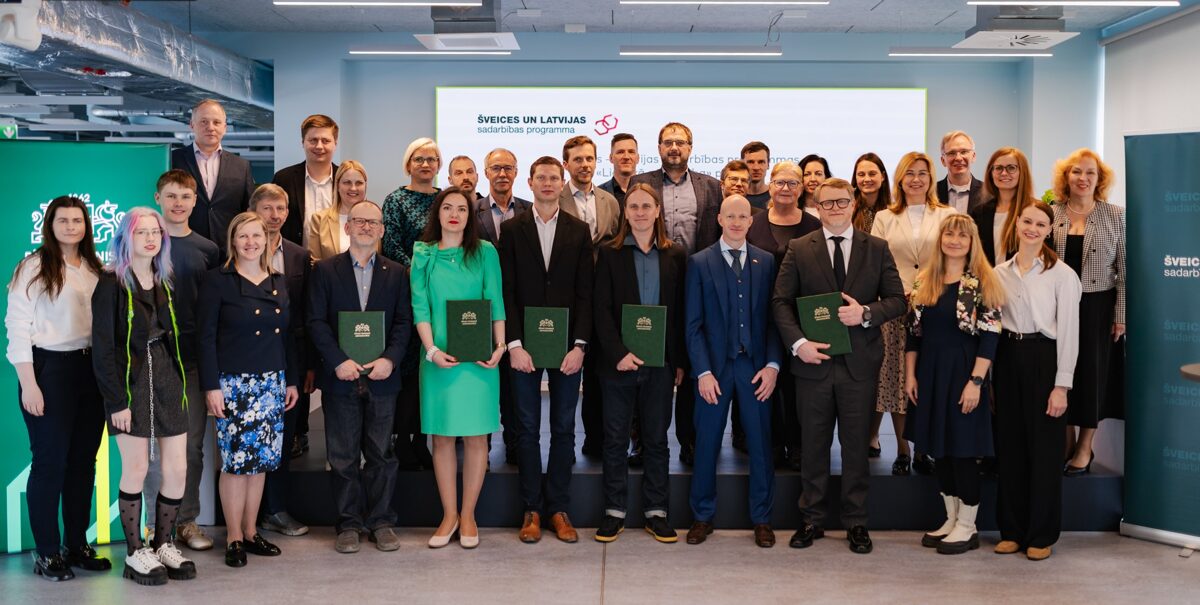 Photo: Ieva Romaško
Photo: Ieva Romaško
On May 22, the Swiss-Latvian Cooperation Programme ‘Applied Research’ project LACHMAT was officially launched at Riga Technical University (RTU). The opening event was attended by Andris Anspoks, director of the LACISE project’s coordinating institution—the Institute of Solid State Physics, University of Latvia—and Maija Bebre, administrative coordinator.
During the event, a Memorandum of Cooperation was signed between RTU, Latvian State Roads (Latvijas Valsts Ceļi), the Latvian Concrete Association (Latvijas Betona Savienība), and the Latvian Road Builders Association (Latvijas Ceļu Būvētājs). The signatories committed to supporting RTU in developing advanced, sustainable concrete and asphalt technologies tailored to market needs.
The LACHMAT project is implemented collaboratively by RTU’s Faculties of Civil and Mechanical Engineering, Science and Technology, and Computer Science, Information Technology and Energy, in partnership with the Swiss Federal Laboratory for Materials Science and Technology (Empa).
The project will run until 2029, fostering close cooperation among RTU researchers across various faculties and Empa scientists. The collaboration aims to develop and accelerate market-ready technologies for reusing road pavements and incorporating bio-based additives in asphalt, advancing environmentally friendly practices in road construction. Specific goals include developing high-performance sprayed concrete to extend bridge lifespans and reduce reconstruction needs, and creating sensor technologies embedded in roadway surfaces to monitor pavement conditions and traffic patterns. These sensors will also contribute to climate adaptation strategies through data collection. Additionally, scientists will work on promoting the sustainability of 3D-printed concrete by developing mixes using locally sourced minerals.
The ‘Applied Research’ programme is part of Switzerland’s contribution to support EU member states in fostering scientific excellence, innovation, and economic growth. With a total fund of €12.3 million, it aims to enhance Latvia’s research capacity, promote innovation, and strengthen international collaboration.
